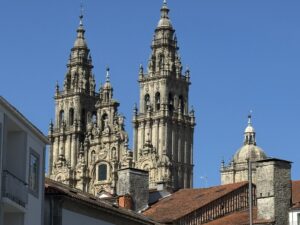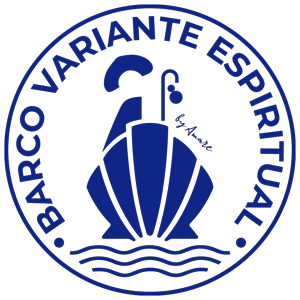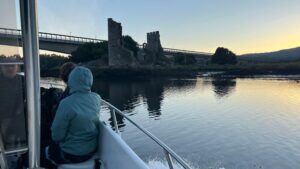Santiago Cathedral: Sacred End of a Journey by Sea and Land
The Santiago Cathedral is not just a jewel of Romanesque, Gothic, and Baroque architecture. It is the spiritual and emotional destination of millions of pilgrims who walk hundreds of kilometers each year in search of a transformative experience ✨. Among them, those who choose the Spiritual Variant of the Portuguese Way end their journey with a unique maritime experience: the Traslatio Route, the only sea stage of the Camino de Santiago.
A Temple with Over a Thousand Years of History 🏰
Located in the heart of Santiago de Compostela, the Cathedral is the undisputed symbol of the city. It was built to house the remains of the Apostle James the Greater, whose tomb was discovered in the 9th century. Since then, it has become the main pilgrimage destination in Europe.
This temple is not only important for its spiritual dimension but also for its historical and architectural relevance. The Cathedral has witnessed the passage of kings, popes, and millions of faithful who, moved by faith, culture, or curiosity, have wanted to live the Jacobean experience firsthand.
Main Features of the Cathedral
- Portico of Glory: A Romanesque masterpiece.
- Botafumeiro: The giant censer that swings across the central nave.
- Crypt of the Apostle: Resting place of Saint James.
- Embrace of the Apostle: A symbolic gesture pilgrims perform upon arrival 🙏.
Every corner of the Cathedral tells a story. From the detailed reliefs of the Portico of Glory to the crypt where the Apostle’s remains lie, the entire site invites contemplation and spiritual reflection. The embrace of the Apostle, located behind the main altar, is one of the most emotional moments for pilgrims who finish their adventure in this sacred place.
ALT text: Facade of Santiago Cathedral, final point of the Traslatio Route
The Traslatio Route: A Direct Connection with the Apostle
According to tradition, after his martyrdom in Jerusalem, the Apostle’s body was transported by his disciples by sea to Galicia. That journey, from the Ría de Arousa to Pontecesures, is what pilgrims relive today aboard the Spiritual Variant Boat.
This nautical pilgrimage offers a unique dimension of the Camino. Sailing the same waters that, according to legend, received the Apostle’s remains, transforms the journey into one full of meaning.
During the voyage, key sites include:
- The Maritime Via Crucis with its stone crosses.
- Cortegada Island, part of the Atlantic Islands National Park 🌿.
- Catoira Towers, ancient defenders of the Ulla River against Viking invasions.
- The Ulla River, flowing into Pontecesures, where pilgrims resume the walk toward Santiago.
ALT text: Pilgrims sailing the Traslatio Route toward Santiago Cathedral
In addition to its spiritual value, the Traslatio Route offers breathtaking scenery: marshlands, forests, migratory birds, and fishing villages that preserve the authenticity of coastal Galicia.

From Boat to Altar: The Final Spiritual Stage
Upon arriving in Pontecesures, pilgrims resume the path on foot for about 25 km to reach the Obradoiro Square, where the Cathedral rises majestically. This blend of sea and land makes the Spiritual Variant one of the most symbolic, scenic, and historically rich routes 🗺️.
Many pilgrims agree that completing this final stage on foot, after sailing, allows them to experience the Camino from a new perspective. The body relaxes after the boat ride, but the spirit awakens in deep reflection on the journey traveled.
It is an ideal experience for those seeking a deeper connection with the origin of the Camino and the figure of the Apostle.
Useful Links to Plan Your Visit
- Santiago Cathedral Schedule
- Book your Traslatio Route journey
- Read more about the Spiritual Variant on our blog
Ready to Experience the Camino with Soul and Sea? 🚶♂️
Book your journey along the Traslatio Route and finish your Camino at the Santiago Cathedral, just as the Apostle’s disciples once did. 🌊⛪
Reserve your spot here or check our online schedule.












